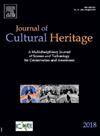多能CT -历史迫击炮的无损研究
IF 3.3
2区 综合性期刊
0 ARCHAEOLOGY
引用次数: 0
摘要
各种各样的工具是可用的,通常用于分析历史砂浆和石膏,包括但不限于,酸消化,薄切片显微镜最终与其他成像分析方法相结合,以及历史上准确的实验砂浆的创建。前两种方法产生可靠的考古数据,但依赖于侵入性取样和/或对样本的破坏。后一种方法可以提供很多关于古代技术的信息,但需要了解原始砂浆参数。典型的x射线计算机断层扫描(CT)可用于诊断石膏的状况(例如,定位裂缝),但在区分构成历史建筑材料的各种化合物方面做得很差。这项工作描述了一种方法,该方法使用多能计算机断层扫描(ME-CT)来提供混合设计的考古数据,可与侵入式和破坏性方法相媲美。本文章由计算机程序翻译,如有差异,请以英文原文为准。
Multi-Energy CT - Nondestructive investigation of historic mortars
A wide variety of tools are available and are commonly used in the analysis of historical mortars and plasters, including but not limited to, acid digestion, thin section microscopy eventually combined with other imaging analytical methods, and the creation of historically accurate experimental mortars. The first two approaches produce reliable archaeometric data, but rely on invasive sampling and/or destruction of the sample. The latter method can be very informative about ancient techniques, but requires knowledge of the original mortar parameters. Typical X-ray Computed Tomography (CT) can be used to diagnose the condition of a plaster (e.g., locate cracks) but does a poor job of differentiating between the various compounds that make up a historical building material. This work describes a method by which Multi-Energy Computed Tomography (ME-CT) is used to provide archaeometric data on the mixing design comparable to the invasive and destructive methods.
求助全文
通过发布文献求助,成功后即可免费获取论文全文。
去求助
来源期刊

Journal of Cultural Heritage
综合性期刊-材料科学:综合
CiteScore
6.80
自引率
9.70%
发文量
166
审稿时长
52 days
期刊介绍:
The Journal of Cultural Heritage publishes original papers which comprise previously unpublished data and present innovative methods concerning all aspects of science and technology of cultural heritage as well as interpretation and theoretical issues related to preservation.
 求助内容:
求助内容: 应助结果提醒方式:
应助结果提醒方式:


